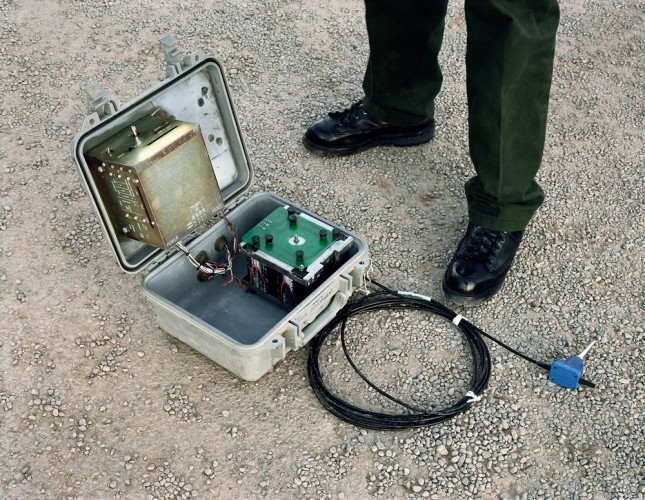
Jenny Holzer, Ribs, 2010. Eleven LED signs with blue, red and white diodes, text: US government documents, 58 1/4 x 5 1/4 x 5 3/4 inches each. Courtesy of the artist and Cheim & Read, New York. © 2010 Jenny Holzer, member Artists Rights Society (ARS), New York. Photo: Richard-Max Tremblay

Trevor Paglen, Five Classified Squadrons, 2007. Five fabric patches, framed, 15 1/4 x 32 3/4 x 2 1/4 inches overall. Courtesy of the artist and Altman Siegel, San Francisco. © Trevor Paglen

David Taylor, Seismic Sensor, Texas, 2007, from the series “Working the Line,” 2007 – 10. Pigment print on aluminum, 29 ½ x 36 ⅜ inches. Courtesy of the artist and James Kelly Contemporary, Santa Fe, New Mexico. © David Taylor

Ahmed Basiony, 30 Days of Running in the Place (still), 2010/2011. Two-channel digital color video installation with two-channel soundtrack; run time and dimensions variable. Footage from the 2010 performance of 30 Days of Running in the Place and the 2011 Tahrir Square protests, edited by Shady El Noshokaty. Courtesy of the Basiony Estate. © Basiony Estate

Trevor Paglen, Untitled (Reaper Drone), 2010. Chromogenic print, 48 x 60 inches. Courtesy of the artist and Altman Siegel, San Francisco. © Trevor Paglen
Ahmed Basiony, Thomas Demand, Hasan Elahi, Harun Farocki, Jenny Holzer, Trevor Paglen and Taryn Simon
Covert Operations: Investigating the Known Unknowns
Covert Operations: Investigating the Known Unknowns is the first major survey of a generation of artists working in the violent and uncertain decade following the 9/11 terrorist attacks to collect and reveal previously unreported information. This group of international artists includes Ahmed Basiony, Thomas Demand, Hasan Elahi, Harun Farocki, Jenny Holzer, Trevor Paglen and Taryn Simon. […]
Sep 28 - Jan 11, 2015
Covert Operations: Investigating the Known Unknowns is the first major survey of a generation of artists working in the violent and uncertain decade following the 9/11 terrorist attacks to collect and reveal previously unreported information. This group of international artists includes Ahmed Basiony, Thomas Demand, Hasan Elahi, Harun Farocki, Jenny Holzer, Trevor Paglen and Taryn Simon. They use legal procedures as well as traditional research methods and resources such as the Freedom of Information Act, government archives, field research and insider connections, to create sophisticated artworks that push beyond conventional thinking. The thirty-seven artworks included in Covert Operations employ the tools of democracy to bear witness to attacks on liberty and to embrace democratic ideals, open government and civil rights.
The exhibition title is a direct reference to Donald Rumsfeld’s eerie insight into our post 9/11 landscape. In 2002 he commented to the press corps: “[T]here are known knowns; there are things we know we know. We also know there are known unknowns; that is to say we know there are some things we do not know. But there are also unknown unknowns—the ones we don’t know we don’t know.” His assertion, although obfuscatory, is both logical and rhetorically accurate. Covert Operations presents works that directly address citizens’ constitutional rights and the vast expansion of federal power. Many of the artists examine the complicity of both governmental and individual actors in human rights violations. Others pry into the hidden institutional structures and economy of the United States intelligence community. Other subjects include Black Sites, the geographic sites of clandestine governmental operations. Still other artists testify to personal discrimination in the name of national security. A visual art exhibition is a potent vehicle for shedding light on the complicated relationship between freedom and security, individuals and the state, fundamental extremism and democracy. As former U.S. Supreme Court Justice Louis Brandeis observed, “Sunshine is said to be the best of disinfectants.”
The exhibition’s rich conceptual themes include secrecy and disclosure, violence, power, subterfuge, surveillance, territory, geography and the visible versus the hidden. Subjects range from classified military sites and reconnaissance satellites to border and immigration surveillance, terrorist profiling to narcotics and human trafficking, illegal extradition flights to nuclear weapons.
Covert Operations will include works by thirteen multidisciplinary visual artists and collaboratives: Ahmed Basiony (Egypt), Thomas Demand (Germany), Electronic Disturbance Theater 2.0 (United States), Hasan Elahi (Bangladesh/United States), Harun Farocki (Germany [German-annexed Czechoslovakia]), David Gurman (United States), Jenny Holzer (United States), Trevor Paglen (United States), Jenny Perlin (United States), Anne-Marie Schleiner and Luis Hernandez Galvan (United States; Mexico), Taryn Simon (United States), David Taylor (United States) and Kerry Tribe (United States).


